June miscellany (1 July 2005)
The chance capture of a breeding pair of Linnets Carduelis cannabina allowed a good demonstration of their sexing characteristics, the male having red on the head and breast, much rustier brown tones on mantle and coverts, and more extensive white on the innermost primaries:
.jpg)
.jpg)
.jpg)
.jpg)
The difference in feather wear is also striking, especially the bleaching at the tips of primaries 4-7. Judging by their tail shape, the male was an adult (Euring age 6, after-second-year) and the female was a second-year (Euring age 5) bird. Thus, the male's plumage was gained in autumn 2004 in its full moult, while the female's feathers are the ones that she left the nest with. First-generation (juvenile) feathers are physically weaker than adult feathers, and more prone to abrasion and bleaching.
Many adult Whitethroats Sylvia communis can also be sexed by their plumage. Males tend to have grey heads, with a clearly defined white throat and a pinkish suffusion to the breast, while the head of females is much more brown, with a less well marked throat. This effect is accentuated in the two birds below, photographed on 18 June 2005, because the male (left) is an after-second-year, Euring age code 6 while the female (right) is a second-year (age 5), as suggested by the difference in eye colour.
.jpg)
.jpg)
Stock Dove Columba oenas would not be on many people's lists of 'pretty' birds, usually being dismissed as a 'grey pigeon'. But in fact their heads contain a spectacular range of colours - plumage with shades of blue, green and purple, and a bill of white, purple and yellow. In bright sunlight (as in the right-hand image) the plumage at the sides and back of the neck shows a metallic sheen, typical of the 'structural' colours that take their colour from the interference phenomenon of reflected light. The different density of barbules in some feathers, and a different viewing angle, causes the feathers to appear to have different colours.
.jpg)
.jpg)
This bird showed two generations of secondary feathers and median/ lesser coverts, allowing it to be aged as a second-year, Euring age 5.
.jpg)
.jpg)
Despite the stunning beauty of the adult birds, their chicks must rank amongst the ugliest, and the smelliest, of all in the avian world:
.jpg)
Jackdaws Corvus monedula, like all corvids, are wary birds, so it was a surprise to me that an adult entered one of my garden traps on 17 June 2005, to be followed two days later by another:
.jpg)
This must be one of the few species in which the iris does not become more red with age.
At this time of year, several MRG members concentrate on recording nests and ringing nestlings. An adult female Kestrel Falco tinnunculus was brooding small young in one of the nest-boxes checked on 15 June 2005 by the Broxton Barn Owl Group, giving us the opportunity to study her interesting moult:
.jpg)
Like most falcons, Kestrels start moulting in the middle of the primaries, usually with p4, and proceed both ascendantly (towards the body) and descendantly (away from the body). The secondaries start with s5 - almost fully-grown on this bird - at the same time as p4. The moult is protracted so that their efficiency of flight is scarcely impaired. As the females are provided with food by the male, they start moult during incubation, around mid-May; males moult from mid-June onwards. The female demonstrated the typical raptor's behaviour of fixing the observer with a 'beady eye':
.jpg)
This habit was also shown by a brood of four Kestrel chicks in another nest-box:
.jpg)
Some more gentle birds were recorded by Nicola Edmonds in her north Wales study area. A nest of Garden Warblers Sylvia borin was an excellent find, only about ten broods a year being ringed in Britain:
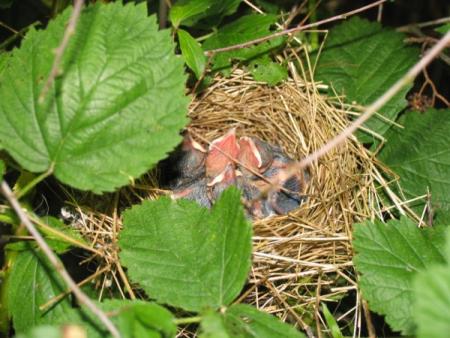
The following three images show broods of Pied Flycatcher Ficedula hypoleuca at different stages of growth, from newly-hatched, to 'in-pin' at about four or five days of age, to 'flight feathers emerging from pin' at about seven or eight days old:
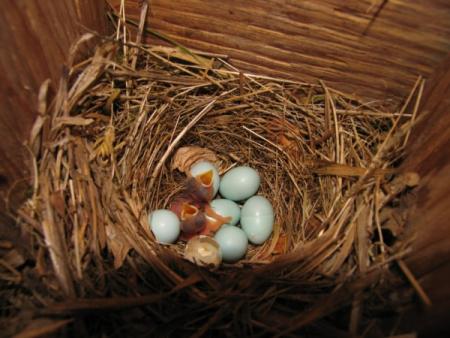
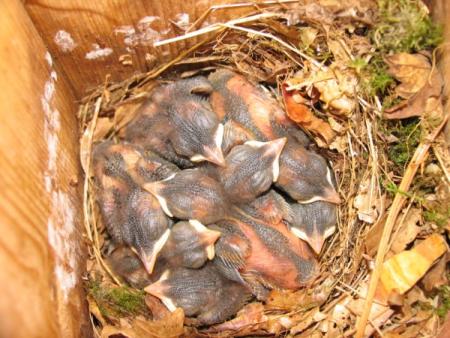
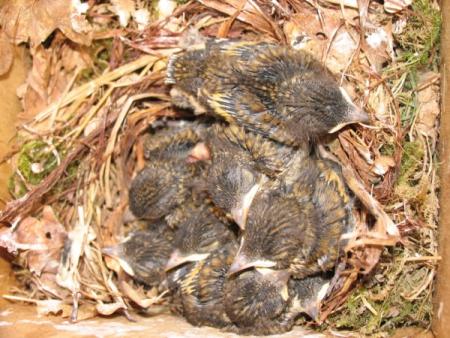
However, even in the apparently gentle world of small passerines, life can be tough. A pair of Blue Tits Parus caeruleus found themselves rearing two Pied Flycatcher chicks with their own brood of eight, the Blue Tit chicks suffering as a result. The flycatcher chicks grow much faster, and are bigger birds anyway, so they took most of the food. By the time of the second photograph below, three of the eight Blue Tit chicks had died.
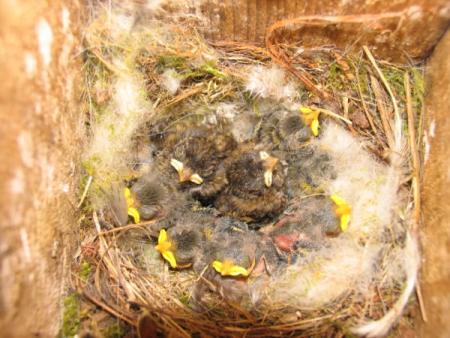
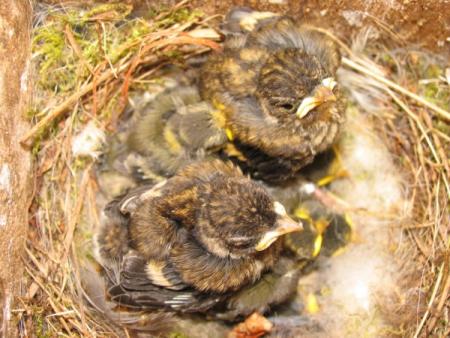
However, the outcome was not good for any of them: on her next visit, Nicola found all of the chicks dead.
David Norman.